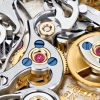Cleaning and oiling balance and jewels
-
Recently Browsing
- No registered users viewing this page.
-
Topics
-
Posts
-
By Neverenoughwatches · Posted
To me this is a simple solution but not just for UK. I know a lot of us are not into facebook groups. But Mark has one, so does Mike Bolton of my retro watches, so does Kalle Slapp. They cost nothing to run, my daughter runs a few dog groups with thousands of members. And it does not have to be actively used, just because you are not interested in facebook ( i wasn't for a very long time ) that doesn't mean you have to participate on it or read anything posted , that is anyone's choice to do so, you give or take what you want from it. Seems the ideal meet place to me, join it , make one or two posts just to say " I'm here " then set it aside for a rainy day. If or when that day comes then discussions can take place as what to do next. -
Hi Bob, Welcome to the forum and thank you for your service. I would never try to discourage you from getting into this wonderful hobby/profession, but please be aware, it does not cost just a few dollars to get into watch repair. Tools are expensive and in many instances the cheap knockoffs are worthless, especially when learning. You can get the tools needed to disassemble, clean, inspect, reassemble and lubricate a watch without spending thousands, but as soon as you start getting into task-specific tools, there are so many and they don’t come cheap. My suggestion is to start with the basics required to disassemble, clean, inspect, reassemble and lubricate only, and build upon that gradually as the need for other tools arises. The advice above regarding starting out on working movements is gold. Many of the non-running watches on eBay have been bought, tinkered with, deemed too difficult and then sold again, often with more damage done each time. Without experience, you clean and service a non-runner and it still doesn’t run. What now? Troubleshooting is difficult as a beginner. This can become very frustrating. I would encourage you to buy a working movement, and learn to strip and service it. If it isn’t running afterwards, you know it’s down to you, and as long as you didn’t damage anything you know that the parts you’ve got can form a ticking watch. An excellent movement to start with is the ETA 6497 clones from China, such as the ST36. They’re not expensive, and although it finds use in some larger wristwatches, this movement was originally designed for use in pocket watches, so everything is larger and easier to see and handle. Once you can service a new ST36 and have it running better than it did when it arrived, you’re definitely ready to step up to working vintage watches and then think about repair of non running or poorly running watches. As far as cleaning solutions go, you will not do better than the commercial watch cleaning and rinsing solutions that are available. You’ll find plenty of suggestions for home brew cleaners online, but the professional products are superior and you want to give yourself every advantage you can, especially when you start working on vintage movements containing hardened decomposed lubricants and often years worth of other dirt and dust. Alcohol is ok for cleaning or rinsing movement parts that don’t contain any shellac. The pallet fork and roller table contain jewels secured with shellac and will tolerate a rinse in alcohol but not prolonged exposure. Methanol dissolves shellac faster than ethanol, and isopropyl alcohol dissolves shellac slower than ethanol. Just in case you don’t know already, the radium on the dial (and likely the hands) of your Dad’s Elgin is highly radioactive. It is safe enough when safely contained within the watch case, but the moment you open the watch and especially when handling the dial or hands you must take precautions against inhaling or ingesting any radium. Best Regards, Mark
-
By LittleWatchShop · Posted
I have both sets and use the K&D 99% of the time. Yes, you have to be careful with the pin. I use a screwdriver to carefully release the pin from the spring. Some skill is involved. I have also modified/replaced the pins in the arbors as necessary. Yeah, you would think a tool would not require modification, but such is the world of watchmaking. There is no perfect tool. Each watchmaker must the tools to his skill, or vice versa. -
I have the 8-11mm K&D but it doesn't do a great job with modern mainsprings, or I have had terrible luck. The arbor pin protrudes too much and I have damaged more springs trying to disengage the arbor than I have successfully wound and inserted. It seems easier to use with old carbon steel springs. My Watchctaft set gets far more use, though I have to get creative to wind left hand springs
-
By RichardHarris123 · Posted
It depends on what the gaskets are made from but silicone lubricant should work. Spray or rub on a generous amount, put in a sealed bag and wait a couple of days. Test for softness and wipe off the excess.
-










Recommended Posts
Join the conversation
You can post now and register later. If you have an account, sign in now to post with your account.
Note: Your post will require moderator approval before it will be visible.